
In 1873 despite the harsh social backdrop, a group of well placed Gibraltarians and British expatriates were finding enough spare time to engage in such things as rowing. At a meeting held on the 3rd March 1873, the unanimous decision to reorganise the then extant 'Boat Club' was reached. Shares, not transferable without the consent of the governing Committee, were made available to members at the cost of 10 Spanish silver dollars each. The Club's enthusiastic membership of the day included such names as Pitman, King, Canepa, Rich, Speed, Recaño, Roberts and Sprague, the last three were to serve on the Club's first elected Committee in 1876. With an unbending resolve to pioneer rowing on the Rock, the then 20-strong membership sat around a table on the 31st March 1876, to focus on augmenting the Membership. Here is a copy of the First Minutes taken:
As agreed at a meeting of the members of the Rowing Club held on the 12th inst. a meeting was held this day for the purpose of reforming the Club under a different basis, the following were present, viz.
Messrs. Sprague, Creswell, Roberts, Recano, Glassford, Richards, Hasluck and Baumgartner. Mr Roberts consented to act as Secretary to the Meeting.
After some discussion it was unanimously carried that, the Club be named "The Calpe Rowing Club".
That it shall consist of an unlimited number of members. The following gentlemen were then elected to serve on the Committee:
President - Mr. W. Glassford,
Vice President - Mr Jos. Porral,
Secretary and Treasurer - Mr. F. Roberts,
Committee Men - Messrs. J. Sprague & J. B. Recaño.
That three shall form a quorum at Committee Meetings.
That the Committee be empowered to frame a set of Rules for the Management of the Club & submit them to a General Meeting for approval.
That the Uniform of the Club be blue jersey, with "Montis Insignia Calpe" on the left breast & straw hat.
Proposed by Mr. Recaño seconded by Mr. Glassford that the Secretary write to the Seville, Cadiz & Puerto Rowing Clubs notifying that the members had been elected honorary members of the Gib Rowing Club.
Carried.
|
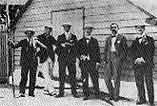
The original boathouse and
an early crew
|
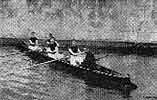
Club boat next to City Wall
before reclamation
|
|

Leading members of the Calpe in the early part of the 20th Century.
BACK ROW: AE Gache, AC Francis, J Serfat, Boatman E Machiavello.
2ND ROW: VJ Galliano, T Haynes, S Gomez-Beare, RMS Capurro, FJW Porral,
WD Piccone, AC Carrara, AN Other, A Aonso, WU Thornton.
FRONT ROW: AL Galliano, AA Freyone, A Hasluck,
Marques de Marzales, HJF Maxted, JH Trennery, A Rugeroni, AHS Capurro.
GROUND: MG Corsi, AL Gareze.
|
As envisaged, the now 'Calpe Rowing Club' began to attract new members who were glad to be paying 10 Spanish Reales de Velon monthly for the privilege. The Membership carried such names as Carrara, Mosley, Cresswell (grandson of the first Packet Agent and later Postmaster, and brother of Vice-Admiral Sir William Cresswell, the founder of the Australian Royal Navy), Thornton, Baumgartner, Bland (of shipping fame), Hasluck and Porral. As the First Minutes of the Club indicates, good marketing vision on the part of J.B. Recaño had persuaded the rest of the Club's newly formed Committee to offer Honorary Membership to other rowing clubs in the neighbouring Spanish cities of Seville and Cadiz and to the club at Puerto Santa Maria.
The Club's wooden boat-sheds had always stood on Devil's Tongue, a short, fortified spit located at Waterport. Fears for the integrity of the wooden shells that were kept on a slipway and exposed to the elements would only allay in 1877, when a formal application for building a boatshed lodged with the Colonial Secretary was granted -albeit at a yearly encroachment fee of 5 shillings. The boathouse was completed in December of that same year at a total cost of 210 Spanish dollars, and the Club's four precious rigs were now well sheltered. Facing east towards the town, the boathouse was accessible only by means of a purpose-built footbridge, and since "jumping the barrier" was strictly prohibited by the encumbent authorities, those rowers who did not return to the area before Waterport Gates were shut were forced to take a ferry to reach the wharf.
|

|
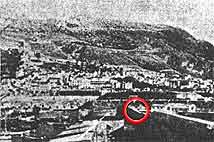
Devil's Tongue at the turn of the
20th century, with CRC boatsheds ringed.
|
These early days of rowing were not entirely restricted to Admiralty waters, and the Club often engaged in competitions away from the Rock. Indeed, a 1876 issue of the Gibraltar Chronicle includes public feedback on one of these particular outings to Puerto Santa Maria, reflecting the differences of opinion on the finer points of close finishes. Permission to land on the Spanish coast could be had on application to the Captain of the Club, and participating members were enjoined to show courtesy and civility at all times to the Spanish officials, and to never disembark unless in the presence of carabineers. Family outings to First Rivers would soon become a bi-annual event, and here the Club's oarsmen engaged in preparatory racing, cheered on by their respective wives and other family members who followed closely behind in chartered steam vessels. Other races would soon take place at Malaga, Seville, Cadiz, Algeciras and Campamento. Sporting links with Club Mediterraneo de Málaga were particularly staunch, and races between Gibraltarians, Malagueños and others became a yearly spectacle. Almost one century on, in 1952, the then 'Club Mediterraneo de Malaga' would host the Spanish Championships, which the Basque Club Ur-Kirolaic won incontestably. The next day, the 17th of August, the new Spanish champions were beaten to the finish by the Calpe rowers, a victory which still draws comments of admiration in both local and Spanish rowing circles. The Calpe crew included, E. Chipulina, bow, O. Requena, 2, C. Ward, 3, J. Alcantara, stroke and J. Dumoulin, cox.
By 1899, the Admiralty had commenced reclamation works along the western sea front and to build roads in its vicinity. It had then become increasingly difficult for shells to negotiate a way in and out of the existing boathouse, and when the area now known as Queensway was earmarked for development it became painfully obvious that Calpe Rowing Club had to move. The Admiralty's Planning Division, however, soon identified an alternative site on the southern side of Devil's Tongue, which was mostly an area of water. The Club readily accepted the offer and agreed to pay an annual fee of 25 shillings to the Authorities. Three years on, some of the spoil removed from the deep excavations at the Dockyard by Admiralty contracted builders Topham, Jones & Railton would be used to fill this area at a cost of ten Spanish centimos per cartload. Tenders were then invited for the construction of the City's retaining walls in the area, and this was awarded to a Mr A. Cruz who had tendered the princely sum of 3,750 pesetas. The Club, however, had to provide the stones. Soon after, the Club would make a payment of £45 to A.W. Ruggier, a Club member, for a wooden house that he had purchased earlier from Topham, Jones & Railton. The house was subsequently dismantled where it had stood, that is, at Devil's Tower Road, and re-erected at Devil's Tongue where it was further modified to serve as clubhouse. During these works, complaints were lodged with the Garrison Adjutant to the effect that certain members of the Club had been seen irreverently, "running about in a state of nudity to the annoyance of ladies and children passing their way." On completion, the Clubhouse was named "Mr Shepherd's House" after a popular foreman who had worked for Topham, Jones & Railton. The episode had lasted more than a decade and had seen the turn of the century as we can see from the following chronology of events recorded in the Club's Minute Books and Files:
|
April 1899
|
Difficulties in taking out and bringing in boats commence and consequently the advisability of finding another site is mooted.
|
|
November 1901
|
New road (Reclamation Road) will leave the Club high and dry. Proposed application for a new site.
|
|
February 1902
|
New site granted.
|
|
March 1905
|
New site officially handed over by D.O., R.E. North Front on 23.3.05 at 10.30 a.m.
|
|
April 1905
|
Reclamation of new site started.
|
|
May 1905
|
10 cents to be paid per cartload of rubbish deposited on reclamation as an inducement to carters.
|
|
April 1907
|
Tender from Mr Antonio Cruz to build walls &c of new Club premises (3,750 ptas.). Club to supply stone only. Building known as Mr Shepherd's house situated at Devil's Tower Road (Block Yard?) was purchased from Mr W.A. Ruggier for £45. This shed belonged to Messrs. Topham, Jones & Railton, the Dockyard works contractors. Taken down and re-erected at Devil's Tongue.
|
|
February 1909
|
Iron shed for new boathouse ordered from Perez Hnos. of Seville (ptas. 16,375).
|
|
March 1909
|
Tender from A. Cruz for construction of foundations, inner walls, &c. for boatshed (3,000 ptas.) was accepted.
|
|
April 1909
|
Debentures for £400 0.4% from members to pay for new Clubhouse, Boatshed, &c.
|
|
June 1909
|
Expenditure approved to erect store, kitchen and workshop, and to construct pier.
Inauguration of new Club & Boathouse by H.E. the Governor about the end of the month.
|
The patrons of the Club have always been Governors of Gibraltar and, in 1909, the new club and boathouse were inaugurated by the then Governor, Sir Frederick Forrestier-Walker, who three years earlier had also donated the annually competed for Challenge Cup that bears his name. In 1908, the Duke of Connaught was appointed Governor and therefore also became the Club's Patron. He too would donate a trophy, the Duke of Connaught's Cup, which has since also been fiercely vied for during the Club's annual rowing festival, the Club Fours.
|
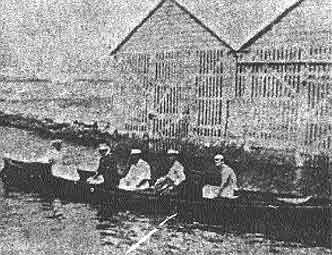
A racing four in the channel or 'moat' between the
City Walls and breakwater
|
|

The Duke of Connaught laying the foundation stone
of the new boathouse in 1908.
|
Although local competitive rowing had always been peculiar to Calpe, by 1899, another club, 'Mediterranean Rowing Club', had appeared on the scene intent on challenging the pioneers at every opportunity. As with the Oxford and Cambridge Boat Race, neither of the two local rowing clubs have ever dominated the annually organized domestic events, both clubs in fact, having taken an equal share of the glory throughout the years. Despite the rivalry, cordial relations have prevailed between the two clubs. Indeed, a good case in point would take us to the dark days of World War II, when the Army requisitioned both Clubs' premises. Calpe were lucky in that their premises were returned to them intact after only 6 months. Mediterranean Rowing Club, on the other hand, had not been so fortunate, having witnessed their premises being razed to the ground. Empathic Calpe, however, would come to their rescue, offering hospitality and temporal joint-use of their premises. The offer was gladly accepted.
In 1852, Harvard rowers had discovered that by greasing their pants they could slide on their fixed seats and use their legs to drive the boat, a rascality that would allow Harvard to dominate Yale, their traditional opponents. This inevitably led to the introduction and popular use of the "rolling-seat" both in America and England. The Calpe rowers had emulated their American colleagues by applying petroleum jelly to the immovable thwarts of the "Mojarra", the "Swift I" and the "Flirt I" which, unlike their modern feather-light and swift counterparts -made of carbon fibre, aluminium and fibreglass- were heavy and ponderous boats. Two years and three boats later, the Club introduced their first rolling-seat gig, naming her, appropriately enough, the "America". Nevertheless, this shell disappointed in her performance because, her body proved too light and impractical when the sea was running high. So, once again, it was back to the faithful fixed-seats of the old "Swift" and "Flirt". Rowing races, however, would thereafter comprise both these types of boats, each category of race in fact, umpired according to their respective, peculiar rules. Nevertheless, and as a matter of Club policy, only those apprentices that had mastered the art of rowing were allowed to pull shells fitted with sliding seats.
Since the Calpe's fragile, narrow shell-built outriggers only performed well in calm seas, it would always prove disadvantageous to compete against the likes of Real Club de Málaga. In order to standardize rowing competitions therefore, and in view that Calpe had no racing boats other than those already mentioned, the Malagueños, who by then had gone from fixed-seats to international 'yolas', forged an even closer association with Calpe by loaning one of their own for a period of two years. It was the "Alfonso XIII", a clinker-built boat that combined the tough seaworthiness of the fixed-seats with the ease of rowing on slides. So excellent had her performance been during this time that, in 1926, Calpe's first yola arrived from Italy. Needless to say, it was named the "Málaga".
From an initial membership of twenty, by 1896 Calpe had attracted a further fifty, a figure that would not fluctuate substantially until the 1930's, when schoolboy members were first admitted. Nevertheless, it would not be until the end of World War II that the membership augmented considerably, a factor that encouraged the Committee of the day to pursue plans to enlarge the Club's premises accordingly.
Calpe Rowing Club has, throughout the years, attracted some very inspiring characters to its membership. The list is long, but a few stand out as truly unforgettable. The first person to spring to mind is Mr Arthur Hasluck, the proprietor of an outfitter's shop in Main Street opposite the Piazza and the present House of Assembly. Hasluck was one of the founder members of Calpe, having also been its Vice-President from 1883 through to 1921. His untiring dedication to Calpe Rowing Club was rewarded in 1908 at a large and well-attended reception held in his honour.
Pablo Larios, the Club's President between 1896 to 1925, and later its Vice-Patron, presented Hasluck with a silver rose bowl and an illuminated address on velum. Mr Larios, who would later became the Marques of Marzales, lived for many years in what is now the City Hall. The "Pepita", the Club's boat between 1911 and 1920, was in fact named after the Marquesa, his wife.
Another popular member was Arthur Freyone who owned an artshop at the time situated south of Irish Town, where Bata, the shoe shop, is today positioned. Freyone had jumped to the rescue of two of his Calpe colleagues in distress, after "Swallow", their boat, capsized as it returned from racing in First Rivers. With his help, Avelino Casola and Alfred Aonso were picked up by a passing Spanish rowboat. Freyone was later awarded the Royal Humane Society's medal.
Another outstanding member to be remembered with affection and admiration would be Enrique Machiavello, a boatman on the Club's payroll for 35 years. During the construction of the Clubhouse he and his wife Dina Rosa had taken up residence in one of the living quarters allocated to the contractors. Here, before the eyes of Calpe's rowing fraternity, they would raise a family. The wartime evacuation saw Enrique and his family move to England from where, sadly enough, he would never return. His son Aurelio would nevertheless carry on at the Club for a number of years.
Then there was Admiral Superintendent and Club Patron, Vice Admiral Sir W. A.D. Acland, who was held in great regard by the Membership. As one of P&O's liners lay in wait to return him to England, he was rowed off at the end of his tour in Calpe's "Swan" and escorted by two others, the "Punch" and the "Calpe". The 1920's had attracted young British telegraph operators to the Rock. One of these was a certain A.D. Ward employed by the Eastern Telegraph Company. Ward, who would visit the Club as often as circumstances permitted, took to rowing, and as bow, he participated in the Sprague Cup, winning four of the last five consecutive races. Ward, however, would leave for Britain soon after, only to return almost forty years on as Gibraltar's appointed Governor and Commander-in-Chief.
Lastly, but not least, the Club remembers such excellent crewmembers as Ramagge, Porral, Fava, Langdon, Bossano, Brow, Sacarello and more recently, Alcantara, Baker and Francis.
 Although traditionally focusing on rowing, Calpe's activities throughout the decades have nevertheless, on many ocassions, crossed the boundaries of sport. For instance, the forefathers of the present 'Royal Gibraltar Regiment' may safely be said to be the 'Gibraltar Volunteer Corps' that was raised in 1915 as result of public demand. The 400-strong Corps and its group of Officers who were mostly Calpe members, served in the Garrison throughout the First World War until disbanded altogether at the end of it. In 1939, the Gibraltarians again volunteered to serve, and the then Governor, General Sir Edmund Ironside, agreed to form the 'Gibraltar Defence Force' (G.D.F.), which paraded for the first time on the 28th April 1939. The Force was retained after the War, principally to serve as a training establishment for National Service. Then, in the early 1950's, the Volunteer Reserve Officers, comprising a total of 40 men, joined this force that was renamed the 'Gibraltar Regiment' in 1958. In the words of Lt. Col. A.J. Ferrary: Although traditionally focusing on rowing, Calpe's activities throughout the decades have nevertheless, on many ocassions, crossed the boundaries of sport. For instance, the forefathers of the present 'Royal Gibraltar Regiment' may safely be said to be the 'Gibraltar Volunteer Corps' that was raised in 1915 as result of public demand. The 400-strong Corps and its group of Officers who were mostly Calpe members, served in the Garrison throughout the First World War until disbanded altogether at the end of it. In 1939, the Gibraltarians again volunteered to serve, and the then Governor, General Sir Edmund Ironside, agreed to form the 'Gibraltar Defence Force' (G.D.F.), which paraded for the first time on the 28th April 1939. The Force was retained after the War, principally to serve as a training establishment for National Service. Then, in the early 1950's, the Volunteer Reserve Officers, comprising a total of 40 men, joined this force that was renamed the 'Gibraltar Regiment' in 1958. In the words of Lt. Col. A.J. Ferrary:
"We had no mess in which to gather and relax after a Sunday's hard drill, and since most of these Officers were Calpe members we sought permission from Calpe to use its Clubhouse".
Permission was granted. A similar situation had developed during 1936, when the Gibraltar Special Constabulary was formed. Its Commandant, Lionel Imossi, an old Calpe member, called upon the Membership to join the organization and, to his delight, many did. Indeed, it could be argued that, eventually, all the senior ranks in the Constabulary had been or were at the time prominent members of Calpe.
But what of Calpe's rowing achievements? In its early days the Club competed in regattas all over the Iberian Peninsula, visiting such places as Málaga in 1892, Seville in 1895, Huelva and Cadiz in 1930 and San Sebastian in 1952. The Club also paid visits to Tangier in 1934 and to Casablanca two years later, also competing effectively in 1936 in Portugal's Figueira da Foz just off Estoril, against French, Belgian, British and Portuguese opposition. Invitations -turned down for a variety of reasons- also came from rowing clubs as far afield as Santander, Paris, Nice, Barcelona, Milan and Kiel. Visitors to the Rock, on the other hand, have included crews from Lisbon, Tangier, Casablanca, RAF Cardington, RAF Benson, a scratch crew from the Thames and the Vesta Rowing Clubs. An unexpected participation in the annual regatta of 1916 was that of four Yale University rowers. Interviewed by Hi Magazine in October 1988, the late Horace Posso, Calpe's Captain between 1925 and 1934, remembered the Club extending an invitation to these four able oarsmen who were members of an American cruise ship berthed in Gibraltar that particular day. The race, involving both local clubs and these four oarsmen, had engendered much expectation and excitement among the local rowing fraternity. Minutes into the race however, and to everyone's dismay and disappointment, one of the American crew lost an oar. Surprisingly, and in spite of the obvious risk to the rest of the crew, he jumped off the outrigger and swam to safety. Undaunted, the three remaining rowers pulled to a brilliant victory.
Two major trophies add to the Club's bulging trophy display cabinet. The first of these, a wall-mounted clock incorporated to a 3-dimensional, life-size bronze lobster, comes from Málaga. Donated as prize by Queen Elizabeth II of Spain in 1892, it was won by The Calpe Rowing Club. The second, and perhaps the more important of the two, was the cup that the victorious Calpe yola rowers lifted during the August Fair at Málaga in 1952. The previous day's racing had declared the Club Ur-Kirolaic of San Sebastian Champions of Spain, but the following afternoon, and against all the odds, Calpe outclassed not only the Basque crew, but also those of Club Maritimo de Barcelona, Grupe Ed El from Gerona, Club de Remos de Tortosa and the now renamed 'Real Club de Málaga'. It had been a great outing.
|
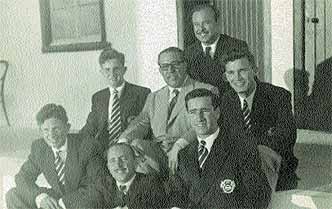
'Los Mirlitos' with President Mr A.F. Gomez
and Captain M.G. Bossano
|
|

Calpe wins the Festival Cup
|
|

The International race, with Mediterranean Rowing Club
nearest to the camera
|
The 1973 annual International Regatta at Gibraltar would mark 100 years of local rowing. Scores of people turned up on Saturday 7th July to spectate this special programme of events. The first race, the 54th Forrestier-Walker Challenge Cup, attracted both local clubs and four crews, three of which were Med's. Although outnumbered, the Calpe crew punished the opposition, finishing the race six lengths ahead of their nearest rivals, clocking 6min. 51sec. The Calpe crew included, Richard Labrador (bow), Ernesto Sanguinetti (no. 2), Abbey Suissa (no. 3), Charles Perez (stroke) and M. Cosquieri (cox). The Festival Cup was the second race staged, and this was also won by persistent Calpe despite their bad start. The crew on this ocassion comprised: A. Hassan (bow), L. Russo (no. 2), C. Goncalvez (no. 3), C. Baker (stroke) and F. Cosquieri (cox). Then came the more important of the three races, the International for the coveted Picadilly Cup. It was a vibrant race from start to finish. Participating were the two local clubs and both the "A" and "B" Moroccan selections. Although Calpe had managed a head start, Med were able to catch up and win by just half a canvas. Morocco's "B" and "A" selections came in a disappointing third and fourth respectively. Med's crew had included Albert Flores, John Goncalvez, Freddie Muscat, Richard Camilleri and L. Alvez.
|
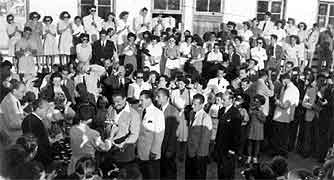
Lady Cottrell presenting trophies at Club Fours (circa 1947)
|
|
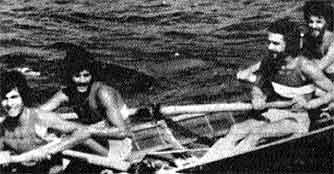
Calpe winners of the first race of the Regatta,
the Forrestier-Walker Cup
|
|

A rapturous reception by Calpe Members and others as
the Red Devils reach port
|
The 1973 rowing season had come to a close on the 28th July with both local rowing clubs having achieved the same degree of success. Whilst Calpe had won the 19th edition of the Falquero Challenge Trophy, Med had taken the 49th race for the Merchants' Challenge Cup. Each Club had in fact lifted the same number of trophies. Mediterranean Rowing Club took the Empire Festivities Cup, the Dunhill Trophy, the Picadilly International and the Merchants' Challenge Cup, whilst Calpe Rowing Club took home the Porral Cup, the Forrestier-Walker Cup, the Festival Cup and the Falquero Challenge Trophy.
The Chronicle's roundup of the 1973 rowing season published on the 31st July ends with the following words:
"...These lads (Calpe' crew), whose proud trainer is veteran and still active oarsman Clive Baker, are not only successful, but exremely ambitious as well as conscientious. I say this because they are planning to row the Strait,....." Further on, the editorial continues: "The only events left to look forward to in the local rowing scene are the traditional Club Fours and, of course, the news of Baker's Boys plans to attempt a first-ever 'yola' crossing of the Strait."
Indeed, barely a week had elapsed when Clive's intrepid Boys set out to make history by becoming the first crew to cross the Strait of Gibraltar on a yola. The choppy seas and heavy winds, however, aborted this first effort after only a few miles. The valiant, resilient team had to wait anxiously before their second attempt. They did not have long to wait however, as the opportunity to do so would arise three days later on the 14th August. It was midday when the crew and trainer arrived at the Yacht Marina, carrying the "Mercury" and ready to board the local yacht 'Gibel-Tarik'. "We'll make it", declared Ernestito Sanguinetti enthusiastically to the attending press. Almost three hours later, Calpe's 'Red Devils', comprising; Richard Labrador, Ernest Sanguinetti, Aby Suissa, Charlie Perez and cox Francis Cosquieri, began their heroic row from Punta Cires. The following official chronology published in the Gibraltar Evening Post that very same evening details life on board the "Mercury" during those three dramatic and exciting hours of almost incessant rowing:
The arrival point was Calpe's slipway where a large and jubilant party had congregated in wait of their heroes. The party obviously included the Club's President, the late Dr Giraldi, who would generously invite all to a free, celebratory drink. About these preliminary celebrations, and on that same evening the Gibraltar Evening Post remarks, humourously:
"I know of at least one person who did not stay on for drinks, it is reported that he was otherwise engaged eating newspapers!"
I wonder whom he was on about!
Sportsworld, a British magazine of the early seventies, would feature the sensational story two months later with a bold running head that read: "Fact". It continued:
"After heavy seas had sank them in 22 minutes at their first attempt, a coxed four of the Calpe RC, Gibraltar, became the first to row the Straits from Morocco to Europa Point, covering 23 miles (37km) in 3hr 5min in an Italian-built yola."
|
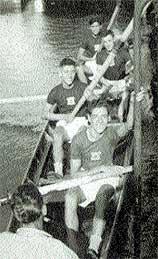
First post-war schoolboy crew and future
office bearers. Stroke: A Bonfante, E Ellul,
J Llambias. Bow: L Rocca. Cox: A Barbara.
Winners of Gache Cup 1954.
|
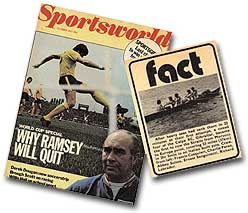
This report appeared in the 1973 issue of Sportsworld, praising the achievement of the Calpe Rowing Club:
'After heavy seas had sank them in 22 minutes at their first attempt, a coxed four of the Calpe RC, Gibraltar,
became the first to row the Straits from Morocco to Europa Point, covering 23 miles (37km) in 3hr 5min in an italian-built yola. Crew, from left: Francis Cosquieri, Charlie Perez, Abbey Suissa, Ernest Sanguinetti, Richard Labrador.'
|
|
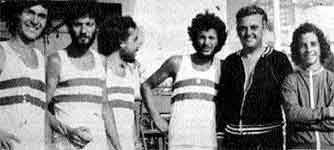
The 'Red Devils' pictured here after the crossing, with Minister
for Sport, the Hon Horace Zammitt. From left of camera: Charlies Perez,
Richard Labrador, Ernestito Sanguinetti, Aby Suissa and F Cosquieri.
|
A week of celebrations ensued, and the Gibraltar Chronicle of the 18th of August reports:
"The Calpe Rowing Club's wonderful week draws to a close today at the Piazza. At the foyer of the House of Assemby the young Calpe oarmen will encourage you to throw your loose change into their Strait-crossing yola Mercury in aid of the local Cancer Research Fund. Calpe RC is riding high on the crest of a wave and amidst the public praise and many banquets, they have invited the local press to join them at the clubhouse this evening - thanks!"
After World War II, the boatman's old quarters had been converted into a dressing room and shower complex. Despite the major reconstruction of the Club much later, the character/spirit of the old clubhouse -albeit in part, had been respected, and its ceiling and some of the old wall panelling were preserved by incorporating the same to the new design by Mr Natalio Langdon, of earlier rowing fame. The clubhouse was nevertheless modified to extend into the open garden and terrace, thereby creating an atmosphere of freshness, light and relaxation that everyone enjoyed. Little did they know that a few decades on, they would have to move!
|
